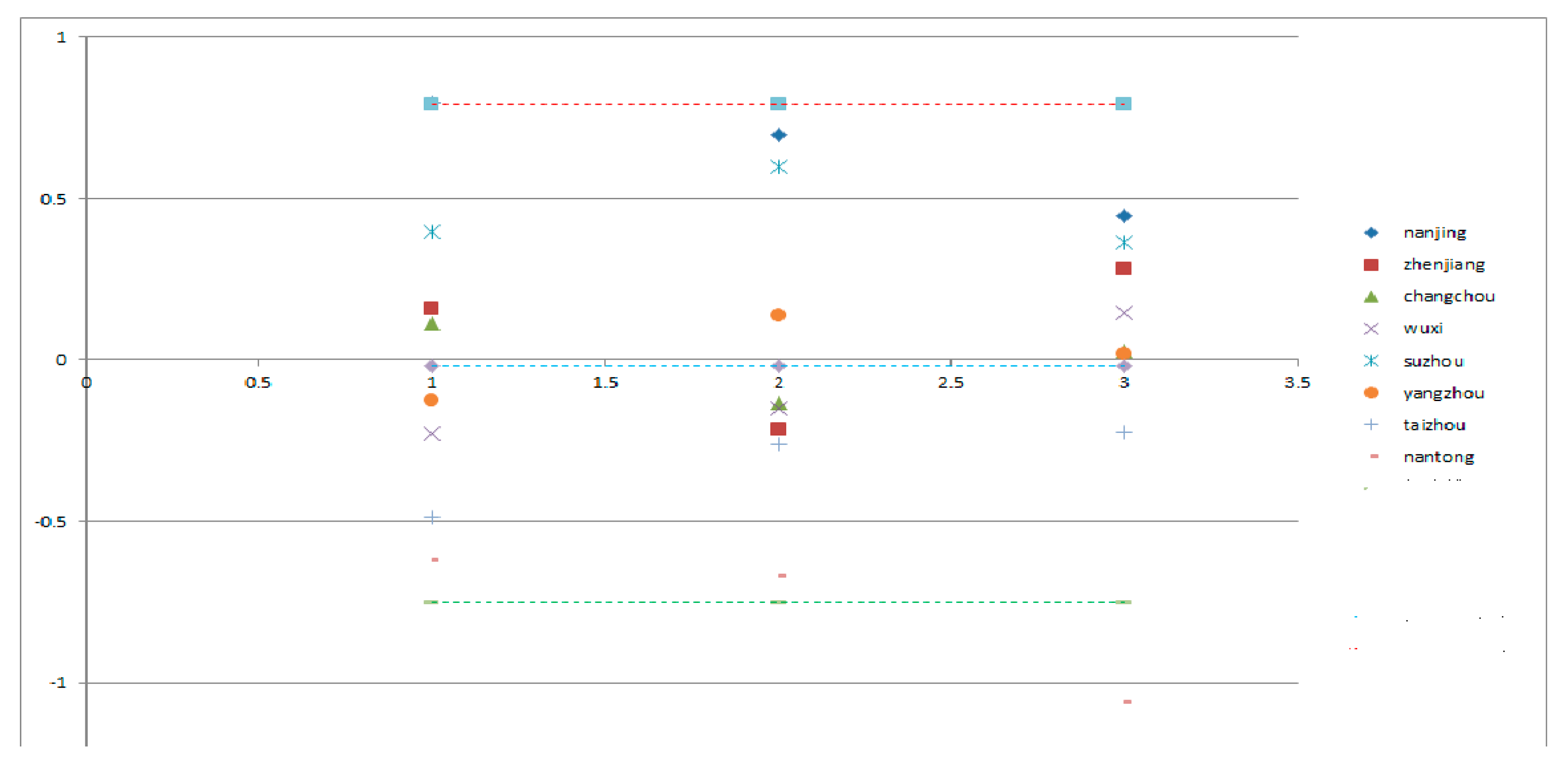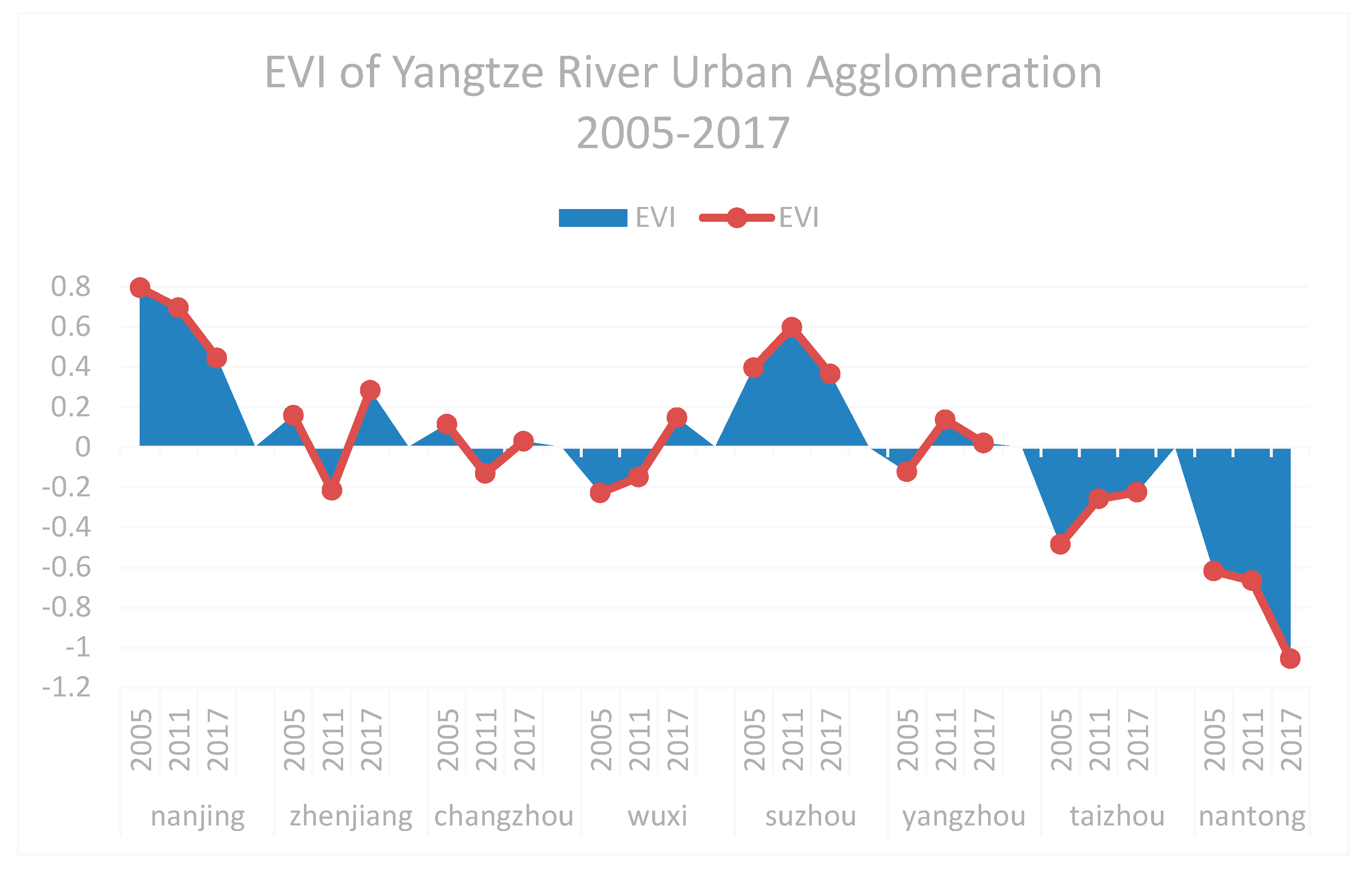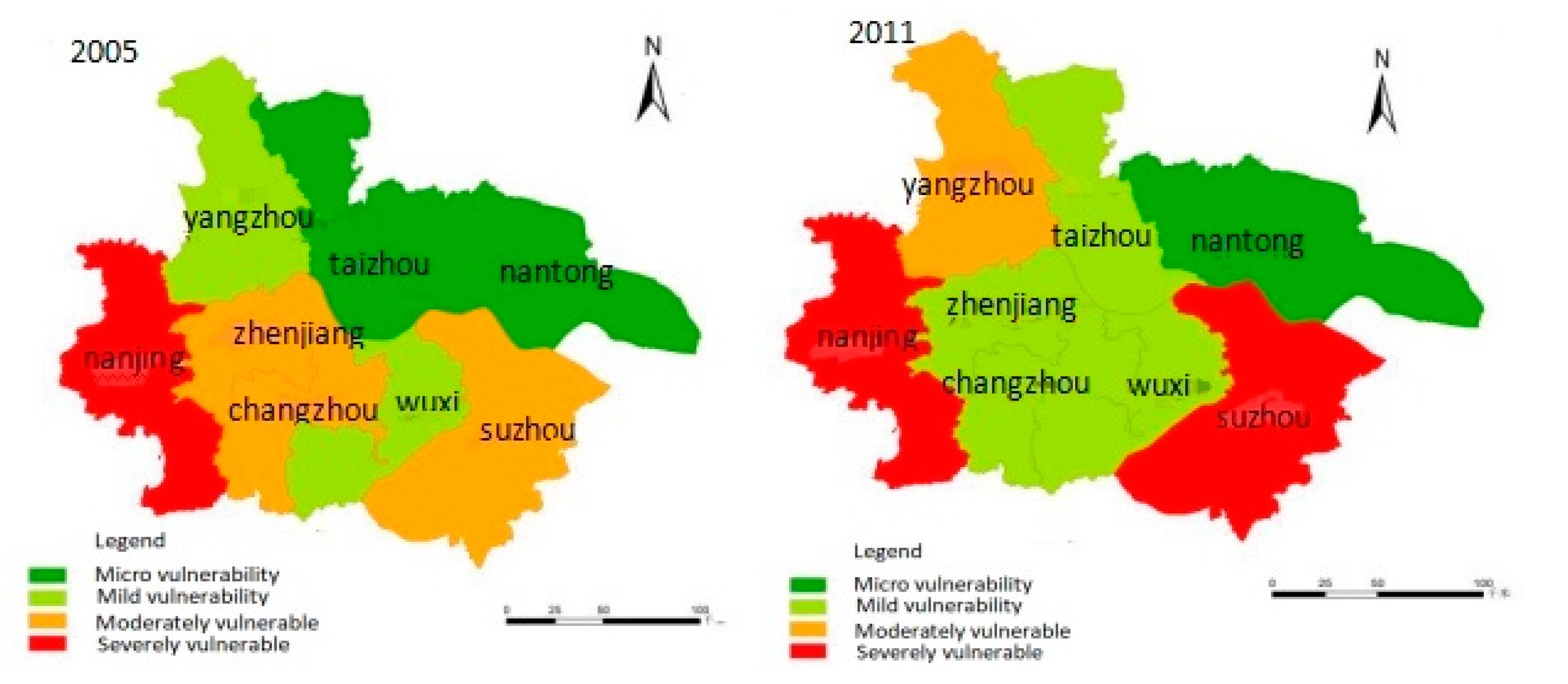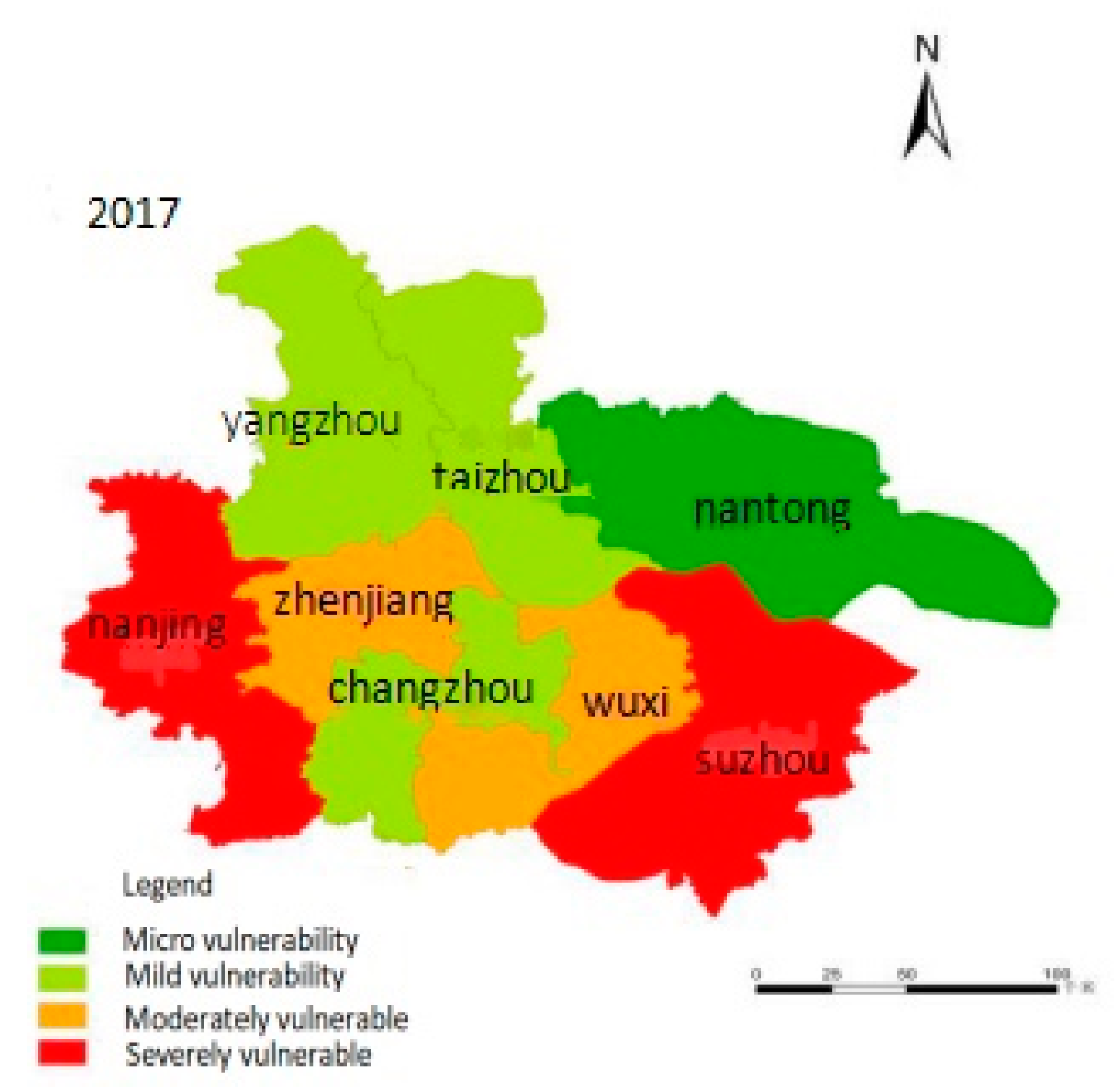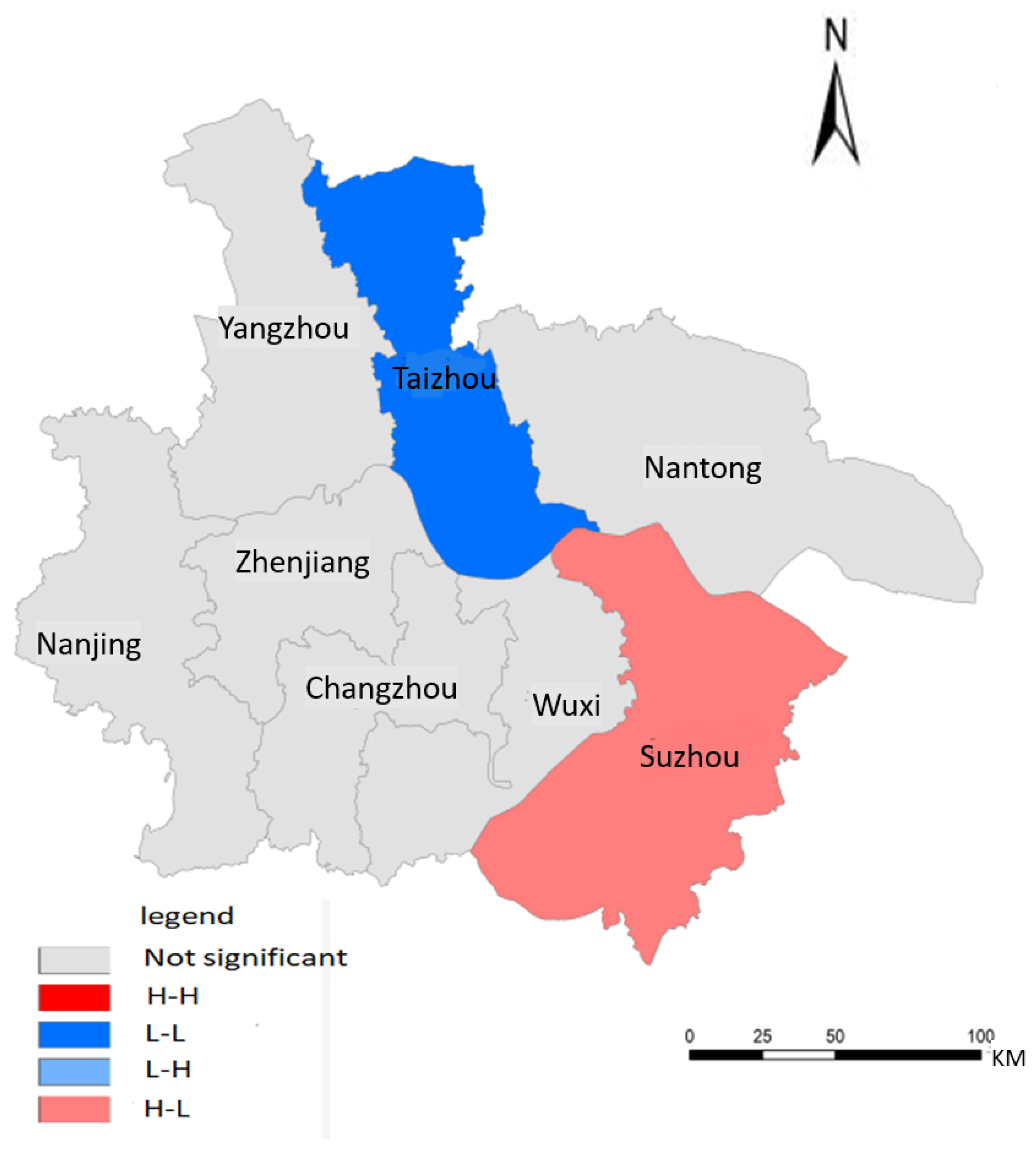1. Introduction
Urban agglomeration is an important form of urban regionalization development [
1]. However, in the process of urban agglomeration development, the construction of ecological environment is neglected. Consequently, contradiction between ecology and urban agglomeration development gradually developed, and the vulnerability of ecological environment has become more prominent. In the early 20th century, Clement, an American scholar, proposed the concept of “ecological transition zone” [
2]. The ecological environment vulnerability refers to the weak ability of the ecological environment that can resist when the regional environment is externally interfered [
3]. The ability to recover after being disturbed is low, and it is difficult to change the current vulnerability status. Currently, ecological and environmental problems such as global warming has reduced per capita arable land, forest resources, supply of fresh water, and biological species [
4]. This destruction has increased the vulnerability of the ecological environment.
China’s urban ecological environment has low carrying capacity, is sensitive and difficult to recover, and has weak anti-interference ability. Barry and Wandel (2006) [
5] studies the ecological adaptability of communities but have not focused on urban agglomerations. However, in the mature stage of urban development, the collection of highly integrated cities forms urban agglomerations [
6]. Under the rapid development of the Yangtze River Urban Agglomeration, it faces problems such as over-exploitation, lagging ecological governance, and imperfect environmental governance mechanisms. These restrict the realization of high-quality development of the ecological environment and the upgrading of urban agglomerations [
7]. From the perspective of ecological environment vulnerability, this article studies the ecological environment of the Yangtze River Urban Agglomeration, solves outstanding environmental problems, examines its ecological environment vulnerability, and explores the driving factors behind it [
8].
At present, scholars at home and abroad have carried out a wealth of research on the vulnerability of ecological environment and achieved fruitful results. From the perspective of research objects, most of them are concentrated in river basins [
9,
10], extremely arid desert climate areas [
11], developed cities [
12], and areas rich in ecological resources [
13], but for the newly divided Yangtze River city group with high level of economic development, high intensity of industrial agglomeration and opening up in recent years. There are few studies on environmental vulnerability. In terms of research methods, the current research on ecological vulnerability evaluation mainly includes SRP evaluation model [
12], analytic hierarchy process [
14], fuzzy cloud model [
15], comprehensive index method [
16], and principal component analysis method [
12]. At the same time, combining MI and Lisa cluster map [
17], geographic information system, and remote sensing data image [
18], quantitative analysis of the driving forces affecting the ecological vulnerability of the study area is carried out. For example, Li et al. (2016) [
12] used the SRP evaluation model to obtain the spatiotemporal dynamics of ecological environment vulnerability in Chaoyang County, Beijing, China. Li et al. (2016) [
12] used principal component analysis to explore the main driving factors of ecological environment vulnerability. However, the existing research methods have the following problems. First, the selection of evaluation factors will have the influence of human subjective factors, which is difficult to reflect the objectivity of evaluation indicators, and the subjective weighting of evaluation factors will also affect the objectivity of results. Second, the repeatability of evaluation indicators, whether it is natural indicators, social and economic indicators, or policy indicators, will have internal indicators. In the evaluation process, there will be redundancy and repeated conclusions. From the perspective of research content, most of them are from the analysis of ecological environment vulnerability, such as biological quantitative characteristics, spatial distribution and differences. The analysis of driving factors and spatial agglomeration characteristics of ecological environment vulnerability in different years is insufficient.
According to the above analysis, the work of this paper is as follows. First, to build the evaluation index of ecological environment vulnerability of Yangtze River Urban Agglomeration. Second, to calculate the index of ecological environment vulnerability, to use the spatial principal component analysis method and Moran index analysis, and to get the interaction relationship between ecological environment vulnerability regions. Finally, to analyze the driving mechanism of ecological environment vulnerability of Yangtze River Urban Agglomeration. This paper summarizes the temporal and spatial evolution law of the ecological environment vulnerability of the Yangtze River Urban Agglomeration and puts forward suggestions and Countermeasures for the green development of the ecological environment of the Yangtze River Urban Agglomeration.
5. Conclusion and Recommendations
Taking the Yangtze River Urban Agglomeration as the research object, the dynamic ecological environment vulnerability index of each region is calculated and classified. Based on the Moran Index (MI), the spatial agglomeration characteristics were obtained, and the spatial and temporal distribution characteristics and driving forces of the ecological environment vulnerability in the region were explored. From the analysis, the results can be summarized as:
(1) The degree of economic development has a great impact on the ecological vulnerability index. Nanjing and Suzhou have been at the forefront of economic development, facing severely fragile ecological risks. The economic aggregates of Nantong and Taizhou in the northeast are behind Nanjing and Suzhou, but the ecological environment is good. In the past 10 years, the industrial structure of Nanjing and Suzhou has focused on the chemical industry. Air pollution, water pollution, and land pollution have caused certain damages to the ecological environment. In addition, increasing population size and distribution have negative impact on the ecological environment.
(2) The spatial agglomeration of ecological fragility is low and the ecological environment hazards among cities are weak. The spatial agglomeration of the Yangtze River Urban Agglomeration has not changed significantly, and the interaction between cities was little. The spatial agglomeration of Suzhou presents high-low concentration, indicating that Suzhou’s ecological environment vulnerability index is large, ecological and environmental issues are significant, and other cities ecological vulnerability index was lower than that of Suzhou. Taizhou, which was a good ecological environment, presents low-low concentration, indicates that the ecological environment of Taizhou and its surrounding cities is good. The spatial agglomeration effect was not significant and it would have a great impact on the economic development of the Yangtze River Urban Agglomeration. In the process of urban development in the new era, the spatial agglomeration effect was significantly more beneficial than disadvantages.
(3) The driving factors of ecological environment vulnerability have changed, and it has been found that from natural factors to social factors to policy factors. In 2005, it was still the initial stage of economic development of the Yangtze River Urban Agglomeration. It is in the stage of economic growth, with good ecological carrying capacity, and can be well digested and treated for human activities. In 2011, the cities within the Yangtze River Urban Agglomeration were gradually developed, and the demand for natural resources was increased, which caused certain damages to the ecological environment. The gradual policy influence factors appear in 2017, and the government has formulated a strategic goal of ecological environmental protection to provide a solid ecological environment for high-quality development. Based on results, the study suggests following recommendations.
The driving factors of the ecological environment vulnerability of the Yangtze River Urban Agglomeration were changed from natural to social economic factors. It is necessary to properly control the population to adapt to the development of the ecological environment, rationally plan to use the land, establish an ecological protection zone, reasonably plan the mileage and location of the railway and highway, and the density of the road network should be consistent with the development of the ecological environment. It is a dire need to strictly control pollution sources, integrate various resources and technologies to rectify contaminated areas, and increase the construction of infrastructure conditions necessary to protect the ecological environment.

